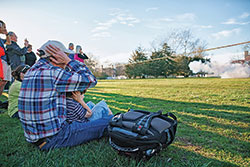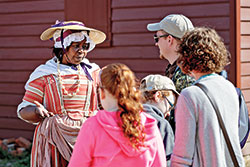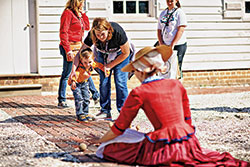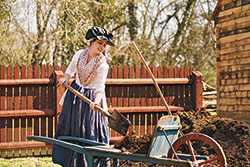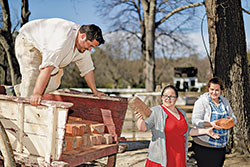Page content
A Chance to Encounter
Step into sensory storytelling that draws guests into the Colonial experience
by Nicole Trifone
Photography by Darnell Vennie
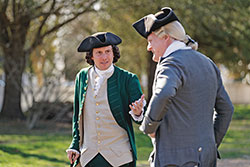
George Mason, portrayed by Joe Ziarko discusses the news of the day with Robert Carter III, portrayed by Gerry Underdown.
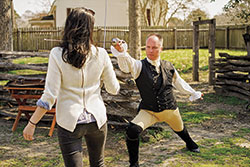
Scott Green, an actor-interpreter, often teaches fencing to guests at the Anderson Blacksmith Shop and Public Armoury.
Immersion into the 18th century begins immediately.
Colonial Williamsburg's guests step off the bus from the Visitor Center, walk up the path toward Market Square and encounter a resident of the Colonial capital. It might be George Washington. Maybe Edith Cumbo. Or perhaps George Mason, in town for a meeting of the House of Burgesses.
Entering the Historic Area, guests see a bustling Market Square. They can talk with townspeople who are out for a stroll in the town common, perhaps make purchases at the market or learn from interpreters at the nearby American Indian delegation or the Magazine.
That first experience in the heart of the Historic Area is just a glimpse of what's to come.
The 2017 season promises guests more engagement with the late 18th century. They will happen upon the many citizens — both the famous and less-famous residents — in more places, more often. They will stumble upon musicians playing in parlor rooms, dancers enjoying a ball, fencing lessons behind the Armoury, cooks preparing supper for a prominent family and Nation Builders entertaining a rapt audience in the Raleigh Tavern's renowned Apollo Room.
"It's a smell from the kitchen that lures you into a story about latticework on pastries. It's the noise from the cooper's shop that lures you into a lesson about the cost of hoops made from hickory saplings," said Ted Maris-Wolf, Colonial Williamsburg's vice president of Education, Research and Historical Interpretation. "These are the hooks that start conversations."
The new approach affects programming throughout the Historic Area, but the efforts will be especially apparent at four sites: the Anderson Blacksmith Shop and Public Armoury, the George Wythe House, the James Geddy House and the Peyton Randolph House.
The Armoury
During the Revolutionary War, the armoury in Williamsburg grew into a manufacturing complex, producing military materials for the Continental Army.
Behind the James Anderson House, tinsmiths are forming canteens, cups, lanterns and other materials for soldiers. Next door, cooks are using military rations to prepare a meal for soldiers. Two more shops, the blacksmith and military artificer, are creating weapons and supplies for the troops.
Simple machines — wheels and axles, levers and pulleys — are set up in the yard. With help from an interpreter, guests can operate the machines that teach about 18th-century manufacturing tools and perhaps offer a little physics lesson, too.
Characters from the 18th century roam the yard, guiding people through some of the history of the armoury complex, hosting a fencing lesson in the back of the yard or demonstrating one of the machines. The mix of spontaneous and planned activities creates a new experience for guests each time they visit the Armoury, whether that second visit is within the same day or months later.
Wythe House
George Wythe, law professor to several famous students — Thomas Jefferson, James Madison and John Marshall, to name a few — infused his lessons with the principles of the Enlightenment and encouraged his students to become well-rounded citizens of the world.
Science — and the Enlightenment's emphasis on empiricism — fascinated and inspired Wythe. Guests to his home can see — and touch — many of the documents, experiments and tools Wythe used to teach himself and the many students who studied in his home.
"If you're going to effect change in the world around you, you better understand that world," Wythe, as interpreted by Chris Hull, said to guests touring his home.
Stumbling upon Wythe or his wife is no longer a rare treat for guests. The Wythes, along with their many well-connected friends, are frequently walking around a property teeming with activity — the sounds of chamber music being played in the parlor room, the sight of the coopers demonstrating their skills in the lumber shop outside and the smells of supper being prepared in the kitchen.
Geddy House
The Geddys are a typical Colonial family looking to use education to better their station in society, and guests to the site will have an up-close look at their daily life. James Geddy Jr. built his family's house in a way that put his silversmith business and his home under the same roof. The Geddys' neighbors and customers are often found visiting the home, ready to demonstrate daily chores, toys, dances and games in which guests can participate.
When the kids need to burn off a little energy, the James Geddy House has plenty of entertainment to do the job. The site has become a central location for activities that would have been enjoyed by children in Colonial times, from the frivolous fun of hoop rolling to the educational fun of learning an instrument.
"You'll notice a very different feel in a lot of the traditional houses," said Peter Seibert, the executive director of the Historic Area. "We really wanted to convey what a home is, and a home is where something is happening all the time. You can come to one property and meet a lot of interesting people and engage in a lot of great conversations; it's not your typical guided tour."
Randolph House
The Peyton Randolph House has long presented the stark contrast between freedom and slavery. While that focus has not changed, the way guests move through the property has.
Randolph played host to many of the Founding Fathers, who were no doubt discussing the core principles of the American Revolution — freedom and independence — while surrounded by those they enslaved, including some of the 27 people who lived under the ownership of Randolph, the first Continental Congress president.
Guests can join a tour of the house or explore on their own the expansive land, including the slave quarters in the backyard. They might hear chamber music inside and African drums outside or find Patrick Henry and James Madison debating the definition of freedom while enslaved people look after the property.
Domestic arts — candlemaking, laundry and cooking — are on full display in the slave quarters of the Randolph House, as well as a chicken coop and kitchen garden that guests can help tend.
With the new approach to programming and interpretation in the Historic Area, guests can choose when — and whether — to interact with history as it unfolds before them.
Experiences may be quiet and casual or can turn into a robust exploration of how a site operated during the Colonial era. A violinist can perform her repertoire uninterrupted, or she can answer questions about a musician's life in the 18th century. A political debate among Nation Builders can draw a crowd of interested listeners or one of vocal joiners, eager to have their say in the discussion.
"Our hope as the world's largest living history museum and the world's largest classroom is that we're helping to reinvent what history education will look like in the future," Maris-Wolf said.

